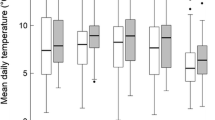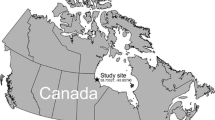Abstract
Surface temperatures have risen globally during the last 30 years, especially in alpine areas. It is recognized that these increases are influencing phenology, physiology and distribution of plants. However, few studies have addressed the effects of climate warming at the species range boundary, where plants are expected to be more stressed. We analysed 11-year data sets of inflorescence production of four alpine plants (Carex foetida, Leucanthemopsis alpina, Senecio incanus, Silene suecica) at the southern boundary of their distribution range in the N-Apennines (N-Italy), in relation to air temperature and snow cover persistence. Inflorescence production of all species fluctuated greatly and was significantly affected by the variation of the mean temperature of June/July. We found significant relationships also between species data series and the snow cover persistence. Moreover, species responded differently to such parameters. One species showed a significant decrease of the reproductive effort, whereas the other three showed a stable trend of inflorescence production. We have shown that some alpine species are favoured by increased temperature and reduced snow cover even at the boundary of their range, where they are thought to be particularly sensitive to warming. However, the aptitude to cope with climate change might be limited by competition against thermophilous species migrating from lower altitude and in some cases by the low altitude of mountain peaks that prevent species upward migration. The individualistic response of species to climate change found here, support the statement that the composition of plant communities might rapidly change in the future.




Similar content being viewed by others
References
Abeli T, Gentili R, Rossi G et al (2009) Can the IUCN criteria be effectively applied to peripheral isolated plant populations? Biodivers Conserv 18:3877–3890
Aeschimann D, Lauber K, Martin Moser D et al (2004) Flora alpina. Zanichelli, Bologna
Alba-Sánchez F, Sabariego-Ruiz S, Díaz de la Guardia C et al (2010) Aerobiological behaviour of six anemophilous taxa in semi-arid environments of southern Europe (Almería, SE Spain). J Arid Environ 74:1381–1391
Ambebe TF, Dang Q-L (2010) Low moisture availability reduces the positive effect of increased soil temperature on biomass production of white birch (Betula papyrifera) seedlings in ambient and elevated carbon dioxide concentration. Nord J Bot 28:104–111
Arft AM, Walker MD, Gurevitch J et al (1999) Responses of tundra plants to experimental warming: meta-analysis of the international tundra experiment. Ecol Monogr 69:491–511
Auer I et al (2007) HISTALP—historical instrumental climatological surface time series of the Greater Alpine Region. Int J Climatol 27:17–46
Baldi M, Dalu G, Maracchi G et al (2006) Heat-waves in the Mediterranean: a local feature or a lager-scale effect? Int J Clim 26:1477–1487
Baptist F, Flahaut C, Streb P et al (2010) No increase in alpine snowbed productivity in response to experimental lengthening of the growing season. Plant Biol 12:755–764
Björk RG, Molau U (2007) Ecology of alpine snowbed and the impact of global change. Arct Antarct Alp Res 39:34–43
Bruni I, De Mattia F, Labra M et al (2011) Genetic variability of relict Rhododendron ferrugineum L. populations in the Northern Apennines with some inferences for a conservation strategy. Plant Biosyst. doi:10.1080/11263504.2011.557093
Ciais P, Reichstein M, Viovyl N et al (2005) Europe-wide reduction in primary productivity caused by the heat and drought in 2003. Science 437:529–533
Cooper EJ, Dullinger S, Semenchuk P (2011) Late snowmelt delays plant development and results in lower reproductive success in the High Arctic. Plant Sci 180:157–167
Cristofanelli P, Bonasoni P, Carboni G et al (2007) Anomalous high ozone concentrations recorded at a high mountain station in Italy in Summer 2003. Atmos Environ 41:1383–1394
Crone EE, Lesica P (2004) Causes of synchronous flowering in Astragalus scaphoides, an iteroparous perennial plant. Ecology 85:1944–1954
Crone EE, Lesica P (2006) Pollen and water limitation in Astragalus scaphoides, a plant that flowers in alternate years. Oecologia 150:40–49
De Boeck HJ et al (2011) Whole-system responses of experimental plant communities to climate extremes imposed in different seasons. New Phytol 189:806–817
Dormann CF, Woodin SJ (2002) Climate change in the Arctic: using plant functional types in a meta-analysis of field experiments. Funct Ecol 16:4–17
Ferrari C, Rossi G (1995) Relationships between plant-communities and late snow melting on mount Prado (Northern Apennines, Italy). Vegetatio 120:49–58
Gaston KJ (2003) The structure and dynamics of geographic ranges. Oxford University Press, New York
Gimenez-Benavides L, Escudero A, Perez-Garcia F (2005) Seed germination of high mountain Mediterranean species: altitudinal, interpopulation and interannual variability. Ecol Res 20:433–444
Giorgi F (2006) Climate change hot-spots. Geophys Res Lett 33:L08707
Green K (2010) Alpine taxa exhibit differing responses to climate warming in the Snowy Mountains of Australia. J Mater Sci 7:167–175
Gruppo di Ricerca Geomorfologia C.N.R. (1982) Geomorfologia del territorio di Febbio tra il M. Cusna e il F. Secchia (Appennino emiliano). Geogr Fis Dinam Quat 5:285–360
Hansen J, Sato M, Ruedy R et al (2006) Global temperature change. Proc Natl Acad Sci USA 103:14288–14293
Haraldsen KB, Wesenberg J (1993) Population genetic analyses of an amphi-atlantic species Lychnis alpina (Caryophyllaceae). Nor J Bot 13:377–387
Hejcman M, Dvorak IJ, Kocianova M et al (2006) Snow depth and vegetation pattern in a late-melting snowbed analyzed by GPS and GIS in the Giant Mountains, Czech Republic. Arctic Antarctic Alpine Res 38:90–98
Hill GB, Henry GHR (2011) Responses of High Arctic wet sedge tundra to climate warming since 1980. Global Change Biol 17:276–287
Hollister RD, Webber PJ, Bay C (2005) Plant response to temperature in northern Alaska: implications for predicting vegetation change. Ecology 86:1562–1570
Hudson JMG, Henry GHR (2009) Increased plant biomass in a High Arctic heath community from 1981 to 2008. Ecology 90:2657–2663
Huelber K, Gottfried M, Pauli H et al (2006) Phenological responses of snowbed species to snow removal dates in the Central Alps: implications for climate warming. Arct Antarct Alp Res 38:99–103
Inouye DW (2008) Effects of climate change on phenology, frost damage, and floral abundance of montane wildflowers. Ecology 89:353–362
Inouye DW, Morales MA, Dodge GJ (2002) Variation in timing and abundance of flowering by Delphinium barbeyi Huth (Ranunculaceae): the roles of snowpack, frost, and La Niña, in the context of climate change. Popul Ecol. doi:10.1007/s00442-001-0835-y
IPCC (2007) Intergovernmental panel on climate change, climate change 2007: synthesis report, contribution of working groups I, II and III to the fourth assessment report of the intergovernmental panel on climate change. IPCC, Geneva
Jolly WM, Dobbertin M, Zimmermann NE et al (2005) Divergent vegetation growth responses to the 2003 heat wave in the Swiss Alps. Geophys Res Lett 32:L18409
Keller F, Körner C (2003) The role of photoperiodism in Alpine plant development. Artic, Antartic. Alpine Res 35(3):361–368
Körner C (1999) Alpine plant life. Springer, Berlin
Kuglitsch FGA, Toreti E, Xoplaki P et al (2010) Heat waves changes in the eastern Mediterranean since 1960. Geophys Res Lett 37:L04802
Leonardi A (2001) Studio bioecologico su popolazioni di specie vegetali rare, per la definizione di parametri di valutazione della loro rarità e precarietà. PhD Disseration, University of Pavia
Leps J, Smilauer P (2003) Multivariate analysis of ecological data using CANOCO. Cambridge University Press, Cambridge
Lesica PB, McCune B (2004) Decline of arctic-alpine plants at the southern margin of their range following a decade of climatic warming. J Veg Sci 15:679–690
Macias M, Andreu L, Bosch O et al (2006) Increasing aridity is enhancing silver Fir Abies Alba (Mill.) water stress in its south-western distribution limit. Clim Change 79:289–313
Nogués-Bravo D, Araújo MB, Errea MP et al (2007) Exposure of global mountain systems to climate warming during the 21st Century. Glob Environ Change 17:420–428
Parolo G, Rossi G (2008) Upward migration of vascular plants following a climate warming trend in the Alps. Basic Appl Ecol 9:100–107
Parsons PA (1990) The metabolic cost of multiple environ-mental stresses: implications for climatic change and conservation. Trends Ecol Evol 5:315–317
Pautasso M, Dehnen-Schmutz K, Holdenrieder O et al (2010) Plant health and global change—some implications for landscape management. Biol Rev 85:729–755
Petraglia A, Tomaselli M (2007) Phytosociological study of the snowbed vegetation in the Northern Apennines (Northern Italy). Phytocoenologia 37:67–98
Pignatti S (1982) Flora d’Italia. Edagricole, Bologna
Piovani P, Leonardi S, Piotti A et al (2010) Conservation genetics of small relic populations of silver fir (Abies alba Mill.) in the northern Apennines. Plant Biosyst 144:683–691
Pyancov PI, Vaskovskii MD (1994) Temperature adaptation of the photosynthetic apparatus of arctic tundra plants Oxyria digyna and Alopecurus alpinus from Wrangel Island. Russ J Plant Physiol 41:454–461
Reisigl H, Keller R (1987) Alpenpflanzen im Lebensraum–Alpine Rasen. Schutt- und Felsvegetation. Gustav Fischer, Stuttgart
Richardson SG, Salisbury FB (1977) Plant response to the light penetrating snow. Ecology 58:1152–1158
Rossi G, Gentili R (2006) Applicazione dei Criteri IUCN a popolazioni periferiche di specie artico-alpine in Appennino settentrionale. Biogeographia 27:307–326
Shi FS, Wu Y, Wu N et al (2010) Different growth and physiological responses to experimental warming of two dominant plant species Elymus nutans and Potentilla anserina in an alpine meadow of the eastern Tibetan Plateau. Photosynthetica 48:437–445
Teuling AJ, Seneviratne SI, Stöckli R et al (2010) Contrasting response of European forest and grassland energy exchange to heatwaves. Nat Geosci. doi:10.1038/NGEO950
Thuiller W, Lavorel S, Araújo MB et al (2005) Climate change threats to plant diversity in Europe. PNAS 102:8245–8250
Tomaselli M (1991) The snow-bed vegetation in the northern Apennines. Vegetatio 94:177–189
Tomaselli M (1994) The vegetation of summit rock faces, talus slopes and grasslands in the northern Apennines (N-Italy). Fitosociologia 26:35–50
Tomaselli M, Rossi G (1994) Phytosociology and ecology of Caricion curvulae vegetation in the northern Apennines (N Italy). Fitosociologia 26:51–62
Van Mantgem PJ, Stephenson NL (2007) Apparent climatically induced increase of tree mortality rates in a temperate forest. Ecol Lett 10:909–916
Walther G-R, Post E, Convey P et al (2002) Ecological responses to recent climate change. Nature 416:389–395
Walther G-R, Beißner S, Burga CA (2005) Trends in the upward shift of alpine plants. J Veg Sci 16:541–548
Weber P, Bugmann H, Rigling A (2007) Radial growth responses to drought of Pinus sylvestris and Quercus pubescens in an inner-Alpine dry valley. J Veg Sci 18:777–792
Wigley TML, Huckstep NJ, Ogilvie AEJ et al (1985) Historical climate impact assessment. In: Kates RW, Ausubel JH, Berberian M (eds) Climate impact assessment. Wiley, New York, pp 3–36
World Meteorological Organization (2011) WMO statement on the status of global climate in 2010. WMO-No. 1074. World Meteorological Organization, Geneva
Acknowledgements
Authors are grateful to Cecilia Amosso, Luigi Bertin, Paolo Cauzzi, Roberto Dellavedova, Tommaso Dones, Martina Gentilini, Andrea Leonardi, Gilberto Parolo (University of Pavia) for their support in the field during the ten-years monitoring. The Appennino Tosco-Emiliano National Park, University of Pavia, L-TER and SHARE (Ev-K2-CNR, Bergamo) for their interest and funding support to the research. Author thanks Prof. Franco Barbaini (University of Pavia) for his suggestions on the statistical analysis. Authors thank Ruth Eastwood (Seed Conservation Department, Royal Botanic Gardens, Kew) for the improvement of the language and Paolo Bonasoni (ISAC-CNR, Bologna) for his useful comments on climate issues and M. Cimone data. We are also grateful to the two anonymous reviewer for their suggestions useful for improving the quality of our manuscript.
Author information
Authors and Affiliations
Corresponding author
Rights and permissions
About this article
Cite this article
Abeli, T., Rossi, G., Gentili, R. et al. Response of alpine plant flower production to temperature and snow cover fluctuation at the species range boundary. Plant Ecol 213, 1–13 (2012). https://doi.org/10.1007/s11258-011-0001-5
Received:
Accepted:
Published:
Issue Date:
DOI: https://doi.org/10.1007/s11258-011-0001-5




